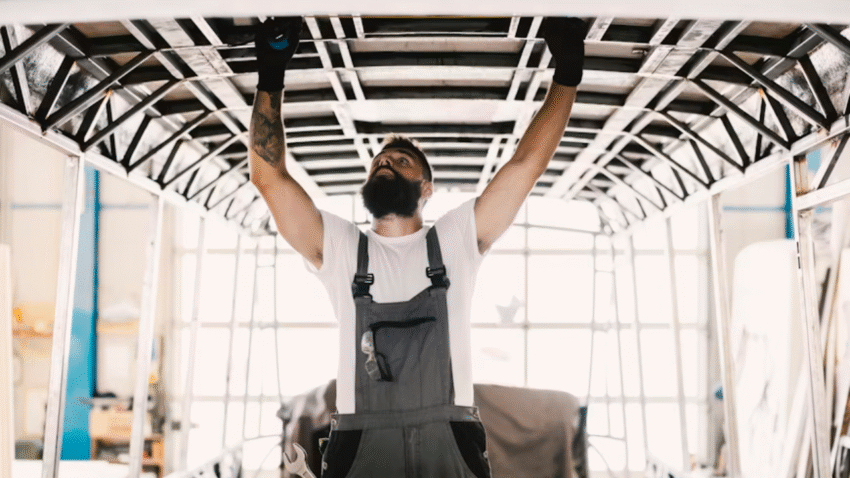Introduction
A fresh coat of paint can completely transform your garage, making it look brighter, cleaner, and more inviting. Whether you use your garage as a workshop, storage space, or just to park your car, learning how to paint garage walls for a clean finish will help you create a professional-looking result that lasts. With proper preparation and the right materials, you can turn dull, stained walls into a neat and polished backdrop.
Why Painting Garage Walls Matters
Painting your garage walls does more than improve aesthetics:
- Protects walls: Paint seals porous surfaces like drywall or concrete, protecting them from moisture, dust, and stains.
- Brightens the space: Lighter colors reflect light better, making the garage feel bigger and more welcoming.
- Improves cleanliness: Painted surfaces are easier to wipe down and keep clean.
- Adds value: A well-finished garage can increase your home’s appeal to buyers.
Whether your walls are drywall, concrete, or masonry, a well-done paint job can make a huge difference in the overall look and function of your garage.
Step-by-Step Guide to Painting Garage Walls for a Clean Finish
1. Choose the Right Paint and Finish
For garage walls, you’ll want paint that’s both durable and easy to clean.
- Type: Use a high-quality latex or acrylic paint for drywall. For concrete or masonry, use masonry-specific paint.
- Finish: Satin or semi-gloss is ideal—they’re more washable and resist stains better than flat finishes.
- Color: Light neutral shades like white, beige, or light gray work best for brightness and versatility.
Pro Tip: Consider using a primer/paint combination to save time if your walls are in good condition.
2. Gather Tools and Materials
You’ll need:
- Paint and primer (if separate)
- Paint rollers (3/8″–1/2″ nap for smooth walls; 3/4″ nap for textured surfaces)
- Paintbrushes for corners and edges
- Roller extension pole
- Painter’s tape
- Drop cloths or plastic sheeting
- Sandpaper (120–150 grit)
- Spackling paste or wall patch kit (for drywall)
- Mild detergent, sponge, and bucket
- Ladder
- Safety gear: gloves, goggles, and mask
3. Prepare the Garage
Clear the Space
Move cars, tools, and stored items away from the walls. Cover floors, shelving, and large objects with drop cloths or plastic sheeting.
Clean the Walls
Dirt, grease, and dust will prevent paint from adhering properly. Wash walls with a solution of mild detergent and warm water, then rinse with clean water and let dry completely.
Repair Damage
- Fill small holes and cracks with spackling paste (for drywall) or patching compound (for concrete).
- Sand smooth once dry.
- For larger repairs, use a wall repair patch kit.
4. Protect Trim, Outlets, and Fixtures
Use painter’s tape to mask off baseboards, door frames, windows, outlets, and switches. Remove outlet covers and light switch plates for a cleaner result.
5. Apply Primer
Primer is especially important for stained walls, raw drywall, or bare concrete:
- For drywall: Use a drywall primer to seal and create a uniform surface.
- For concrete or masonry: Use a masonry primer or block filler to improve adhesion and coverage.
- Apply with a roller for large areas and a brush for edges and corners.
- Allow primer to dry fully before painting (check product instructions).
6. Paint the Edges First
Use a brush to “cut in” along the edges, corners, around outlets, and along the ceiling line. This ensures clean lines and makes rolling the rest of the wall easier.
7. Roll the First Coat
- Pour paint into a roller tray.
- Load the roller evenly—avoid oversaturating.
- Work in sections, rolling in a “W” or “M” pattern to spread paint evenly, then fill in gaps with straight strokes.
- Maintain a wet edge to avoid lap marks.
Pro Tip: Start from the top of the wall and work downward for the smoothest coverage.
8. Apply the Second Coat
Once the first coat is completely dry (usually 4–6 hours), apply a second coat for a richer, more even finish. This also increases durability and coverage.
9. Remove Painter’s Tape and Touch Up
Remove painter’s tape while the second coat is still slightly wet to avoid peeling. Use a small brush to touch up any missed spots or thin areas.
Common Mistakes to Avoid
- Mistake: Skipping wall cleaning.
Solution: Always clean walls first to ensure proper adhesion. - Mistake: Using the wrong paint finish.
Solution: Choose satin or semi-gloss for durability and ease of cleaning. - Mistake: Painting over damaged areas.
Solution: Repair cracks and holes before painting. - Mistake: Not using primer on bare surfaces.
Solution: Always prime for better coverage and adhesion. - Mistake: Applying thick coats.
Solution: Use thin, even coats to prevent drips and uneven drying.
Extra Garage Tips & Hacks
- Add a Feature Wall: Consider using a bold accent color on one wall for a stylish, customized look.
- Use Mold-Resistant Paint: Great for garages in humid climates to prevent mildew.
- Consider Epoxy Wall Coatings: For ultimate durability, especially in heavy-use garages.
For a complete garage transformation, see our guide on How to Paint a Garage Door Like a Pro to match your fresh walls with an updated exterior.
Conclusion
Painting your garage walls for a clean finish is one of the most affordable ways to improve your space’s look and functionality. By preparing the walls properly, using the right materials, and applying paint with care, you can achieve a professional result that will last for years.
Final Tip: Don’t rush the prep stage—it’s the foundation of a flawless paint job.
CTA: Bookmark this guide and use it the next time your garage walls need a bright, fresh upgrade.
